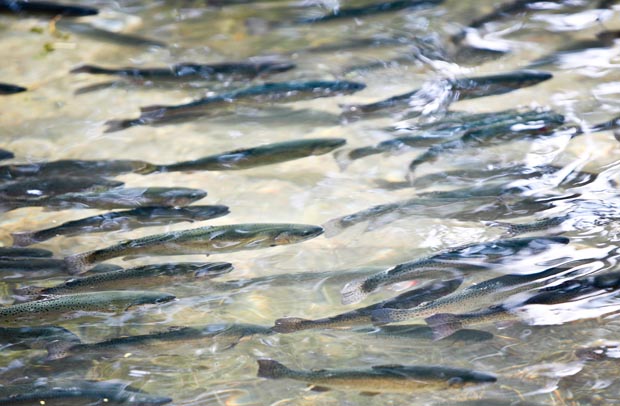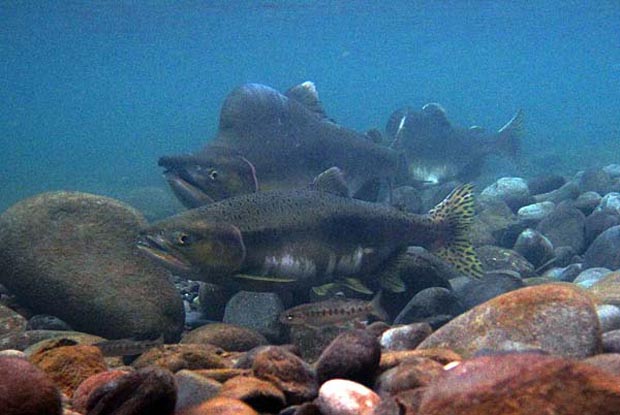Is wild “Too much of a good thing?”
The following article by Jessica Short (HEALTHY EATING) caught our attention and generated an impromptu – unscientific study/survey of our angling friends and family members known for their predilection for eating pescados and their clinging, scampering and mud dwelling relatives. Here’s what we found out:
About a third of the respondents (family and friends not known for their angling interests) were not aware of their grocery store bought pescados and their relatives are more than likely farm raised, and if in a can, most likely from a third world country (Vietnam – Thailand, and others).
Regarding canned items, almost all said they didn’t look at the “From” label (oyster, clams, anchovies, sardines, etc.).
Most had heard of the concerns regarding farm raised and overfishing the wild stocks.
About a third said they stuck exclusively with wild caught for their omega needs. Oddly, all said they ate tuna fish from a can. Is that exclusively?
Another third said they only bought from highly respected and dedicated fish monger establishments. Or, if available, wild caught.
Those living in rural, non-coastal areas of the country bought less fish than those that have access to fresh fish or cities that supported great fish monger stores.
So what’s the conclusion,? read on . . .
[dropcap]H[/dropcap]ere’s some easy advice: Eat fish twice a week to get your heart-healthy omega-3 fatty acids.![]()
But with the farm-raised or wild-caught debate, how do you decide what to put on your barbecue grill? Not so easy to answer.
Nutritional value varies from species to species, plus the source has pros and cons for nutrition, contamination and environmental impact.
Fish from dark, cold waters naturally have more Omega-3s and include salmon, rainbow trout, anchovies, sardines, bass, herring and tuna. But Google “farm vs. wild” and brace yourself! The controversy is complex. And, information from every source — news media, online and scientific journals — is often contradictory.
Issues fall into three categories: environmental concerns, contamination and omega-3 fatty acid levels. Both wild and farmed salmon have low levels of mercury, PCBs (polychlorinated biphenyls) and other contaminants and must adhere to FDA limits. And, although farmed fish has higher PCB levels, it’s still under the danger zone.
If you’d like to “fish or cut bait,” my suggestion is to choose wild-caught whenever possible, but don’t be ridged. It’s more important to get those omega 3s. All fish, wild or farmed, must adhere to FDA limits for PCB content and mercury levels.
Rely on trusted information sources. I like NOAA’s FishWatch site, MedLine Plus and Seafood Watch from the Monterey Bay Aquarium. Or take a short-cut and ask our Community Health Education Center librarians. They’ll compile the latest, vetted information on any health topic on the spot. You also can check out books from the library.
Farmed fish PROS
Price: Often cheaper and more readily available than wild fish.
Controlled diet: Some farmed fish can have higher levels of Omega-3s because fish farmers can better control diet — making sure that their fish eat more feed that is converted into Omega-3s than a fish might normally eat in the wild. However, there is really no way for consumers to gauge the amount of Omega-3’s in one piece of fish versus another.
Ecology: Farmed fish pose a lower danger of overfishing (or depleting) the population of wild fish.
Farmed fish CONS
Contamination: Farmed fish usually contain more contaminants. They’re fed processed pellets, often made from processed anchovies, sardines and other small fish. Farmed salmon, for example, has been found to contain seven times more PCBs, dioxins and pesticides than wild salmon
Antibiotics: Farmed fish are more subject to disease, which spreads quickly throughout the entire pen. To control disease, farmed fish are often given antibiotics.
Lower Omega-3s: While farmed fish can be fed an enhanced diet to increase its Omega-3s, there’s no way to tell whether one piece of fish contains more than another. According to The American Journal of Clinical Nutrition, farmed salmon contains two or three times fewer Omega-3s.
Wild fish PROS
Flavor: Many people prefer the taste of wild fish. Farmed fish do not have as much room to move as their wild cousins, which reduces the amount of muscle they can develop and affects texture and taste.
Appearance: Wild salmon naturally is bright in color due to its food source (krill and other small sea creatures), while farmed salmon is grayish in color and dyes must be added to bring the flesh to an appealing shade.
Nutrition: Wild fish are usually healthier (higher in Omega-3s) and less contaminated than farmed fish.
Wild fish CONS:
Overfishing: Most marine biologists agree that eventually supply won’t meet demand. Overfishing can deplete certain species of fish, which affects the ecosystem at large.
Price: Fresh wild fish is sometimes hard to find and usually more expensive than farmed fish.
Distance traveled: Not every fish lover lives on the coast or near a fishery. An Alaskan salmon, for example, must be shipped thousands of miles to reach a grocery store near you.
Fish Wish List:
- Salmon (wild-caught)
- Albacore Tuna (troll- or pole-caught, from the U.S. or British Columbia)
- Freshwater coho salmon (farmed in US tank systems)
- Oysters (farmed)
- Pacific Sardines (wild-caught)
- Rainbow Trout (farmed)
So is wild or farmed fish better? It depends on a wide range of factors from the quality of fish farming practices, the type of fish and the waters it comes from. Stick to the list above and you can enjoy you seafood with a clear conscience and a healthy heart.
[information]
How you prepare fish is also important. Salmon, for example, is a “fatty” fish because of the high omega-3 content, so it’s best on the grill or baked. My crowd-pleaser recipe here . . .
Jessica Short is a registered dietitian for Salem health. Contact her at CHEC@salemhealth.org.
Seafood Watch from the Monterey Bay Aquarium
[/information]








